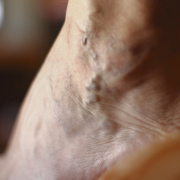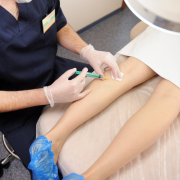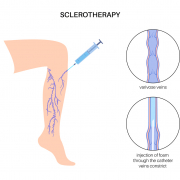Long-Term Care After Sclerotherapy
Sclerotherapy is a common cosmetic procedure that is nearly 100 years old and has been performed on countless patients successfully. It’s a minimally invasive procedure for those with spider or varicose veins. The procedure entails injecting a solution directly into problematic veins, which causes them to collapse and eventually fade away.
Proper care after sclerotherapy is essential to achieving the best possible results. If you’re new to the procedure, you might be wondering what should be done after sclerotherapy, which activities to avoid, and how long it will take to completely recover after sclerotherapy. Read on to learn more.
What is Sclerotherapy?
Sclerotherapy is a procedure done to eliminate the appearance of varicose and spider veins. It is often done for cosmetic purposes, but is also useful in relieving symptoms of varicose or spider veins, such as aching and swelling.
Your doctor will perform a physical examination before the procedure to evaluate the abnormal veins and check for any associated blood vessel diseases. You will also be asked about your medical history, allergies, and any previous treatments.
Every sclerotherapy session typically takes about 30 minutes to complete, based on your veins’ condition. It’s recommended to wear loose, comfortable clothes and avoid applying lotion to the area on the day of the procedure.
Sclerotherapy is an outpatient procedure that is performed in the doctor’s office. The affected area will be cleansed, then a solution will be injected using a very fine needle directly into the problematic vein. The number of injections needed in each session is based on the size and number of veins.
After Treatment Care
Immediately Following Sclerotherapy
Recovery from sclerotherapy is often short, but it is crucial to properly care for yourself during this time. The following are some of the instructions your doctor will likely give you. Always adhere to your doctor’s instructions for the best results possible.
- Wear compression stockings for at least 2-3 weeks following the procedure.
- Take care of your wound by leaving the bandage in place for about 2 days after the procedure.
- Keep the treated site clean and dry.
- Avoid being sedentary during your recovery. Walking is considered a crucial part of your recovery.
- Avoid strenuous activities and high-impact workouts for at least one week following treatment.
- Avoid aspirin, ibuprofen, and other anti-inflammatory medications. Tylenol may be taken if needed to relieve pain.
- Avoid hot baths, whirlpools, and saunas for at least a week. If you need to take a shower, keep the water lukewarm or colder.
- Avoid applying a hot compress or any form of heat to the treated area.
- Avoid direct sunlight exposure, including sun tanning and tanning beds.
Long-Term Care
Fortunately, there isn’t much long-term care required after sclerotherapy. The veins treated with the procedure will fade away and won’t be a problem any longer. However, since sclerotherapy doesn’t stop new varicose and spider veins from forming, long-term care focuses on prevention. Examples of long-term care include maintaining a healthy weight, exercising, not staying sedentary for long periods of time, taking breaks if you have to stand for several hours at a time, wearing compression stockings, and maintaining a healthy diet. These steps can prevent the pooling of blood in the legs and improve blood circulation – both of which are preventive measures against varicose and spider vein formation.
Sclerotherapy in Kansas City & Marshall, MO
Want to know more about treatment options for vein disease or if sclerotherapy is the right option for your condition? Schedule a consultation with the best vein doctor in Kansas City today by calling (816) 792-3400 or by filling out our appointment request form online.












